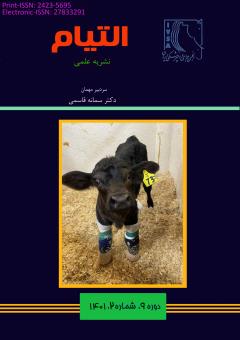روشهای بی¬حسی موضعی بخش انتهای اندامها در گاو
محورهای موضوعی : علوم جراحی دامپزشکی شامل جراحی های بافت های سخت و نرم
محمد علی صادقی
1
![]() ,
سمانه قاسمی
2
*
,
سمانه قاسمی
2
*
![]()
1 - دانشجو، گروه علوم درمانگاهی دانشکده دامپزشکی دانشگاه فردوسی مشهد، مشهد، ایران
2 - استادیار، گروه علوم درمانگاهی دانشکده دامپزشکی دانشگاه فردوسی مشهد، مشهد، ایران
کلید واژه: اندام, بیحسی موضعی, گاو ,
چکیده مقاله :
گاوها معمولا مقید سازی فیزیکی را تحمل می کنند بنابراین، بسیاری از روش های درمانی و جراحی شامل جراحی های اندام حرکتی را می توان با استفاده از ترکیب آرام بخشی ملایم و بی حسی موضعی یا ناحیه ای انجام داد. این روش ها از خطرات بیهوشی عمومی اجتناب می کنند و نسبتا ساده و ارزان با عوارض جانبی کم هستند. بی حسی موضعی یا ناحیه ای شامل تزریق داروی بی حسی است که از بین رفتن حس را در یک بخش از بدن فراهم می آورد. استفاده مناسب از بی حسی های موضعی ابزاری مهم جهت انجام روش های درمانی و جراحی در اندام های حرکتی گاو است. مهم است که بی حسی موضعی بی دردی کافی را برای کنترل درد فراهم آورد. لیدوکایین معمول ترین داروی بیحسی موضعی است که در گاو استفاده می شود. چندین روش بی حسی موضعی و ناحیه ای شامل بی حسی عصبی، بی حسی حلقوی، بی حسی چهار نقطه ای و بی حسی ناحیه ای سیاهرگی برای بخش پایینی اندام ها در گاو وجود دارد. در بی حسی ناحیه ای، داروی بی حسی نزدیک یک عصب خاص تزریق می شود در حالی که بی حسی حلقوی با تزریق داروی بی حسی به صورت دورتادور انجام می شود. در بی حسی چهار نقطه ای، داروی بی حسی در چهار نقطه بهمنظور بی حس کردن بخش پایینی اندام از پسترن به سمت پایین تزریق می شود. در بی حسی ناحیه ای سیاهرگی، داروی بی حسی به صورت داخل سیاهرگی از طریق یک کاتاتر، پس از قرار دادن تورنیکت دورتادور اندام تزریق می شود. توجه به حجم داروی بی حسی موضعی جهت پیشگیری از اثرات سمی این داروها ضروری است. در این مقاله، معمول ترین روش های بی حسی موضعی در بخش انتهایی اندام ها گاو شرح داده می شود.
Cattle usually tolerate physical restraint so, many surgical or therapeutic techniques including limbs procedures can be performed by using a combination of mild sedation and local or reginal anesthesia. These techniques avoid the risk of general anesthetic and are relatively simple and inexpensive with low side effects. Local or reginal anesthesia involve the local anesthetic drug that provide the absence of sensation in a region of body. Use of appropriate of local anesthesia is an important tool to perform different therapeutic and surgical procedures in limbs of cattle. It is important that local anesthesia provides sufficient analgesia for pain management. Lidocaine is the most common local anesthetic drug used in cattle. Before injection, the skin should be cleaned to reduce the chance of introducing pathogens. There are several techniques of local and reginal anesthesia including nerve block, ring block, four-point and, intravenous regional anesthesia for distal limbs in cattle. In nerve block, an anesthetic drug injects near specific nerves while ring block performs by injection of an anesthetic drug circumferentially around the mid-metacarpus or metacarpus region. In low four-point block, local anesthetic drug is injected in four sites to anesthetize the lower limb from pastern distally. During intravenous regional anesthesia, an anesthetic drug is intravenously injected by a catheter followed by the placement of a tourniquet around the limb. Consideration to the volume of used local anesthetic drug is necessary for prevention of toxic effect of these drugs. In this article, the most common local anesthetic techniques of the distal limbs in cattle are described.
1. Mansour M, Wilhite R, Rowe J. Guide to ruminant anatomy: dissection and clinical aspects: John Wiley & Sons; 2017.
2. Tranquilli WJ, Thurmon JC, Grimm KA. Lumb and Jones' veterinary anesthesia and analgesia: John Wiley & Sons; 2013.
3. Grimm KA, Lamont LA, Tranquilli WJ, Greene SA, Robertson SA. Veterinary anesthesia and analgesia: John Wiley & Sons; 2015.
4. Clarke KW, Trim CM. Veterinary anaesthesia e-book: Elsevier Health Sciences; 2013.
5. Fubini SL, Ducharme N. Farm animal surgery-e-book: Elsevier health sciences; 2016.
6. Estebe J-P, Davies JM, Richebe P. The pneumatic tourniquet: mechanical, ischaemia–reperfusion and systemic effects. European Journal of Anaesthesiology 2011;28(6):404-411.
7. Bell N, Mahendran S. Local anaesthesia and analgesia guidance for surgical treatment of cows with necrotic hoof lesions. Livestock. 2017;22(6):298-304.
8. Lin H, Passler T, Clark-Price S. Farm animal anesthesia: cattle, small ruminants, camelids, and pigs: John Wiley & Sons; 2022.
9. Kruse H, Christensen KP, Møller AM, Gögenur I. Tourniquet use during ankle surgery leads to increased postoperative opioid use. Journal of Clinical Anesthesia. 2015;27(5):380-384.
10. Adams HR. Veterinary pharmacology and therapeutics: Iowa state university press; 2001.
11. Lin H, Passler T, Clark-Price S. Farm animal anesthesia: cattle, small ruminants, camelids, and pigs: John Wiley & Sons; 2022. 12. Klenerman L. Tourniquet time-how long? Hand. 1980(3):231-234.

